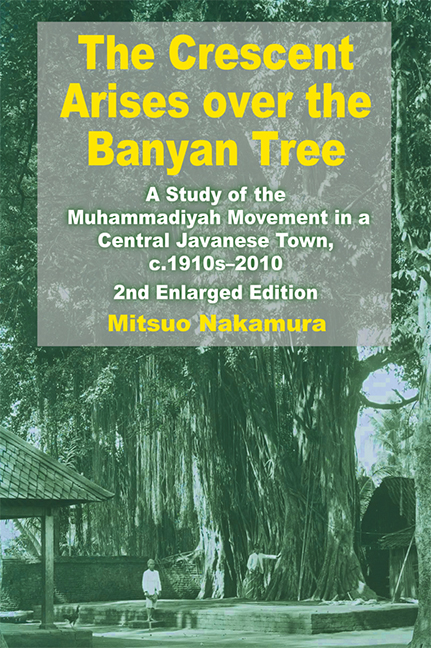 The Crescent Arises over the Banyan Tree
The Crescent Arises over the Banyan Tree Book contents
- Frontmatter
- Dedication
- Epigraph
- Contents
- List of Figures and Maps
- List of Tables
- List of Boxes
- Foreword to the Second Edition
- Preface to the Second Edition
- Foreword to the First Edition
- Preface to the First Edition
- Notes
- Map
- PART I DEVELOPMENT OF THE MUHAMMADIYAH IN KOTAGEDE, c.1910s–1972
- PART II KOTAGEDE REVISITED, 1972–2010
- Epigraph
- Map
- Introduction to Part II
- 8 Social Changes in Kotagede, 1972–2010
- 9 The Achievements of the Muhammadiyah
- 10 Internal Dynamics of the Muhammadiyah Movement
- 11 Challenges Facing the Muhammadiyah
- 12 Festival Kotagede: Conflict and Integration
- 13 The May 2006 Earthquake and Reconstruction of Kotagede
- 14 Concluding Remarks: Future of the Muhammadiyah
- Postscript to Part II
- Bibliography
- Glossary
- Appendices
- Index
- About the Author
8 - Social Changes in Kotagede, 1972–2010
from PART II - KOTAGEDE REVISITED, 1972–2010
Published online by Cambridge University Press: 21 October 2015
- Frontmatter
- Dedication
- Epigraph
- Contents
- List of Figures and Maps
- List of Tables
- List of Boxes
- Foreword to the Second Edition
- Preface to the Second Edition
- Foreword to the First Edition
- Preface to the First Edition
- Notes
- Map
- PART I DEVELOPMENT OF THE MUHAMMADIYAH IN KOTAGEDE, c.1910s–1972
- PART II KOTAGEDE REVISITED, 1972–2010
- Epigraph
- Map
- Introduction to Part II
- 8 Social Changes in Kotagede, 1972–2010
- 9 The Achievements of the Muhammadiyah
- 10 Internal Dynamics of the Muhammadiyah Movement
- 11 Challenges Facing the Muhammadiyah
- 12 Festival Kotagede: Conflict and Integration
- 13 The May 2006 Earthquake and Reconstruction of Kotagede
- 14 Concluding Remarks: Future of the Muhammadiyah
- Postscript to Part II
- Bibliography
- Glossary
- Appendices
- Index
- About the Author
Summary
ADMINISTRATIVE RE-DESIGNATION
It must be mentioned in advance when dealing with social changes in Kotagede that the town has undergone administrative re-designation since the original study for this book was conducted in 1970–72. The “Kemantren (Ward) of Kotagede, Jka (Jogjakarta)”, has changed its name to “Kecamatan (Subdistrict) Kotagede” and is one of the fourteen sub-districts constituting the City (Kota) of Yogyakarta. The geographic boundary of Kecamatan Kotagede, however, remains the same as that of former Kemantren Kotagede. The ten Rukun Kampungs (RK or neighbourhood association) which constituted the Kemantren of Kotagede before (see Figure 2.1) are now rearranged into three groups, forming three Kelurahans (Kl. or urban community) as follows: (1) Kl. Rejowinangun consisting of four ex-RKs, i.e., Rejowinangun, Gedongkuning, Pinalan and Tinalan; (2) Kl. Prenggan, of two ex-RKs, i.e. Prenggan and Tegalgendu; and (3) Kl. Purbayan, of four ex-RKs, i.e. Gedongan, Basen, Alun-Alun, and Purbayan. Each Kelurahan is further divided into Rukun Warga (RW or residents association), and the RW further into Rukun Tetangga (RT or neighbours association). There are all together 40 RWs and 164 RTs in the Kecamatan Kotagede. The area of Kecamatan Kotagede is sometimes called “Kotagede Administratip (= administrative Kotagede)”.
Meanwhile, those areas, which were formerly designated as “Kotagede Ska (Surakarta)” belonging to the Kabupaten (Regency) of Bantul, no longer bear the name Kotagede, not to speak of Ska, at all at present. Former Kalurahan Jagalan Kotagede Ska, Kalurahan Singosaren Kotagede Ska and Kalurahan Mutihan Kotagede Ska are now simply called Desa Jagalan and Desa Singosaren, both belonging to Kelurahan Banguntapan, and Desa Mutihan belonging to Kelurahan Wirokerten — all forming part of Kabupaten Bantul. Desa Jagalan, which occupies the core part of the old town of Kotagede, has five RWs divided into fourteen Kampungs (abbreviated as Kp.). In spite of all these new administrative designations, the former core areas of Kotagede (see Figure 2.2) are still regarded by most of the residents as a single socio-cultural entity in terms of geographic proximity, network of family and marriage, closeness in social interaction, cooperation in economic activities, commonness in customs, and a shared local history with a number of prominent remnants from the past. Perhaps for these reasons, those areas of Kotagede are still semi-officially called “Kawasan Kotagede” (= Kotagede Region)1 especially for the promotion of tourism.
- Type
- Chapter
- Information
- The Crescent Arises over the Banyan TreeA Study of the Muhammadiyah Movement in a Central Javanese Town, c.1910s-2010 (Second Enlarged Edition), pp. 221 - 252Publisher: ISEAS–Yusof Ishak InstitutePrint publication year: 2012
